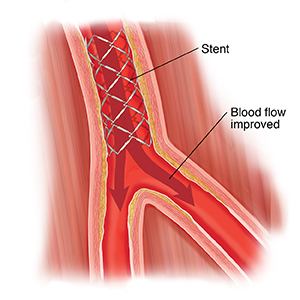Peripheral Arterial Angioplasty and Stent
Peripheral arterial angioplasty is a procedure done to treat a narrowed or blocked artery in your arm or leg. It brings blood flow back to your arm or leg. It also helps ease symptoms. Sometimes a metal mesh tube called a stent may be put in your artery. It holds your artery open. The procedure is done by a specially trained healthcare provider called an interventional radiologist. This healthcare provider is trained and certified by the American Board of Radiology to use minimally invasive image-guided procedures to diagnose and treat diseases. A vascular surgeon may also do this procedure.

Before your procedure
Follow any directions you are given on how to get ready, such as not eating or drinking before the procedure.
Tell your healthcare provider if you:
-
Are allergic to X-ray dye (contrast medium) or other medicines
-
Are breastfeeding
-
Are pregnant or think you may be pregnant
-
Have had any recent illnesses
-
Have any health conditions
Tell your healthcare provider about any medicines you are taking. You may need to stop taking all or some of these before the procedure. This includes:
-
All prescription medicines
-
Herbs, vitamins, and other supplements
-
Over-the-counter medicines, such as aspirin or ibuprofen
-
Illegal drugs
During your procedure
-
An IV (intravenous) line is put into your vein in your hand or arm. The IV line gives you fluids and medicines. You may be given medicine to help you relax and make you sleepy (sedation). Medicine will be put in your skin to numb the area where the cut (incision) will be done. This is to keep you from feeling pain at the site.
-
A very small incision is made at the insertion site. A thin, flexible tube (catheter) is put through the incision into your artery. The radiologist watches the catheter’s movement on a screen.
-
X-ray dye is injected through the catheter into your artery. It helps the radiologist see the artery more clearly on the X-rays. The radiologist uses these images as a guide. They move the catheter to the narrowed or blocked part of your artery.
-
When the catheter reaches the narrowed or blocked part, the radiologist inflates a special balloon attached to the catheter. This is called angioplasty. Inflating the balloon widens the passage through the artery.
-
Sometimes the artery won't stay open after the angioplasty. In this case, a stent is needed. A catheter with a stent attached is threaded through the artery. When the stent is in the right place, it is opened.
-
When the procedure is done, all catheters and balloons are removed. The stent stays in place. Pressure is put on the insertion site for 15 minutes to stop bleeding.
After your procedure
-
Your healthcare provider will tell you how long to lie down and keep the insertion site still.
-
You may stay in the hospital for a few hours or overnight.
-
Drink plenty of fluids to help flush the X-ray dye from your body.
-
After you go home, care for the insertion site as directed. Call your provider if you have any problems.
-
You may need to take aspirin or a blood-thinning medicine (anticoagulant) after the procedure. It can help prevent blood clots in the stent. Talk with your healthcare provider about this.
Possible risks
All procedures have some risk. Possible risks of peripheral arterial angioplasty and stent are:
-
Bleeding or infection at the insertion site
-
Damage to the artery, including the blockage getting worse. This may need surgery to fix.
-
Problems because of X-ray dye, such as allergic reaction or kidney damage
-
Artery becoming blocked again (restenosis), which often happens within 6 to 18 months
-
Low-level exposure to X-ray radiation, which is considered a safe level
© 2000-2024 The StayWell Company, LLC. All rights reserved. This information is not intended as a substitute for professional medical care. Always follow your healthcare professional's instructions.